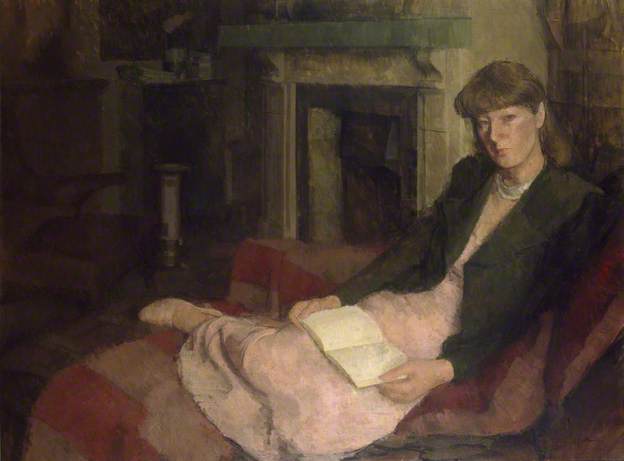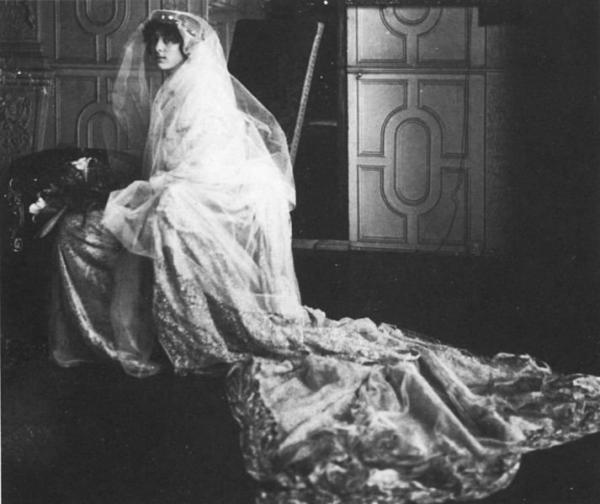
The publication of Cheerful Weather for the Wedding coincided with the breakdown of Julia Strachey’s own marriage to the bisexual, depressive, alcoholic, sculptor, Stephen Tomlin, whose mother, according to Frances Partridge was the model for the monstrously self-absorbed Mrs Thatcham. Julia’s own mother had been a remote figure since her divorce from Julia’s father, Oliver Strachey, so one can only conjecture who might have fussed around Julia herself on the day of her own wedding: one of the Strachey aunts perhaps, Elinor to whom she was sent aged only five, while her father remained in India, or Dorothea, married to the painter Simon Bussy, in whose house she would write Cheerful Weather.
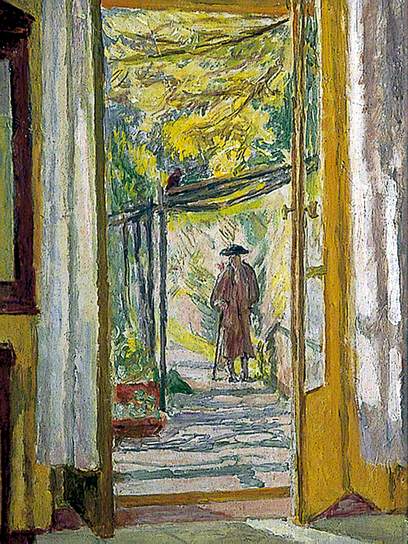
Or might it have been her step-mother, Ray Costelloe, niece of Bertrand Russel’s first wife, Alys Persall-Smith, known to Julia as ‘Aunty Loo’. So many familiar Bloomsbury names. Was Uncle Lytton present? Tommy, as Stephen was known, had been involved both with Lytton Strachey and with Dora Carrington, breaking off his relationship with Carrington to marry Julia. Little surprise that Julia’s view of love and marriage as she entered her thirties should have been more than a little jaundiced.
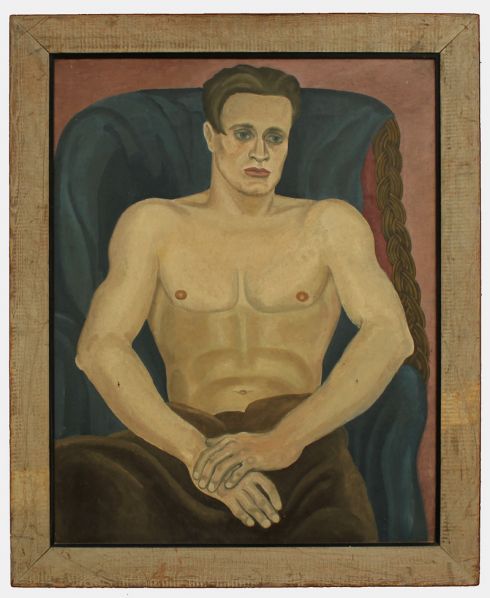
The weather may be cheerful for Dolly Thatcham’s wedding – certainly her mother insists that it is so, although Dolly’s friend Evelyn notes wryly that her one criterion for this is ‘whether or not is possible to see across as far as the Malton Downs’ – but little else is. Least of all the bride. A collection of Thatcham relations, friends, and a few old retainers are gathered together on a cold March day, more to observe than to support : the bossy younger sister, an aged aunt who must be cosseted, the cousins, a precocious child, two quarrelsome grumpy teenagers, a drunken twenty year old who needs watching – anyone who has ever organised a wedding will be familiar with the cast – and Bob, Canon Dakin who will be giving Dolly away. Cousin Bob is giving her away, Mrs Thatcham is marrying her daughter to the Hon Owen Bigham, standard, accepted wedding language, but Julia Strachey uses it in such a way as to leave the reader in no doubt, from the opening sentence, that Dolly is not in control. Little wonder that later, aware that ‘something remarkable and upsetting in her life was steadily going forward’, she will feel the need to fortify herself with a bottle of Jamaica rum.
From the start, Julia Strachey sweeps away conventional notions of the radiant bride: Dolly has the ‘glittering eyes of a sick woman who is exhausted, yet feverish’; and plays mischievously with her readers’ expectations. When on the morning of her wedding a maid hands her a faded blue leather bag found behind an old bureau, surely, we think, she will find a touching memento, a love letter. She idly fantasizes about hundreds of lost cheques, or ‘that wretched gold thimble of cook’s I lost’, a casually dropped cutting reference to Dolly’s heartlessness towards the servants. The reality is that the promised repository of her past contains nothing but a crumpled bus ticket (no destination) and an achingly boring and implicitly critical letter from her mother. The biscuit crumbs may, as it turns out, be telling, but the author does not dwell on them.
Strachey relies, to a very large extent on dialogue to convey the narrative, and fill in, in a very limited fashion, the past (one is reminded rather of her near contemporary Ivy Compton-Burnett), trusting the reader to pick up details, weigh their significance, and judge their veracity. Cheerful Weather is a social comedy in the sense that The Cherry Orchard is a comedy: like E.M. Forster and Virginia Woolf, and other Bloomsbury ‘elders’, Julia greatly admired Chekhov. She places a small cast on a restricted set and the principal action, the wedding of the title, takes place off-stage. The characters step ‘outside’ only for a moment, to wave goodbye to the newly-weds, when the weather turns out to be markedly less than cheerful (although Mrs Thatcham will deny this), and in ‘the cutting, furiously buffeting wind, amid the cries of good-bye, bowing down before the storms of rice and confetti, the lack of high spirits on the part of the bride and bridegroom passed unnoticed’.
Things unnoticed, unsaid, unheard, misunderstood make up the comedy and the tragedy. The characters talk, but fail to have any meaningful exchanges with one another. They talk at cross purposes, they don’t say what they mean, they don’t hear, they fail to understand each other or elicit an appropriate response for any number of reasons, mumbling, senility, obtuseness, because they are too self-absorbed or too drunk. Mad Nellie from the village talks to the tea tray.
Leitmotifs pepper the conversation, if it can be called that: a hideous hand-painted lampshade, wedding present from a rich neighbour, lime green socks worn by one brother and disapproved of by another, food, in the wrong place, at the wrong time – orders given, countermanded, repeated … And for added comedy, the traditional element of farce, several people are allotted the same bedroom: Dolly’s younger sister, the wisest, member of the extended family (not the kindest – her remark to Dolly, that life after her departure ‘will not be so demoralising for the servants’ is accurate, but ill-timed) tries to correct her mother. Predictably, she cannot make herself heard, but the reader hears and delightedly awaits the consequences of Mrs Thatcham’s misplaced confidence in her own powers of organisation.
If there is comedy in the mis-hearing, there is something unsettling rather than comic about the visual tricks that the house seems to play. Rooms are full, excessively full of greenery, potted plants, and a multitude of reflective surfaces, an Indian brass tray, Moorish paper knives, a Serbian embroidery (foreign travel is hinted at, but not confirmed), the light is constantly changing, sometimes almost blinding, often confusing. Dolly looks through an old blackened mirror at the drawing-room and it appears ‘forever swimming in an eerie, dead-looking, metallic twilight, such as is never experienced in the actual world outside.’ Neither ears nor eyes can be trusted. And things seem to take on a life of their own. Dolly is transfixed, suffocated, by her wedding veil: ‘Gigantic billowing fold upon fold of lacy birds and flowers seemed heaped up over the bed, the rocking chair, the table and everywhere.’
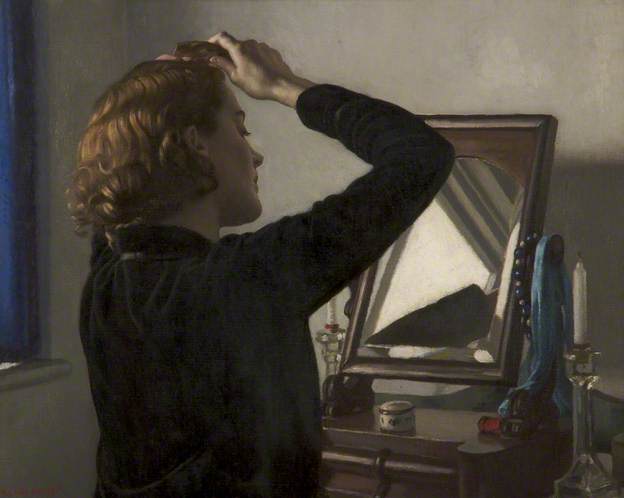
Eyes can be orange, flesh yellow and wrinkled as a grocer’s apricot, or black as ebony. Nobody is beautiful: Kitty’s hands look like ‘raw meat chops appearing from the delicate yellow gauze sleeves of her bridesmaid’s frock’, Dolly has a white face with ‘thick and heavily curled back lips’, little altered by the make-up that she applies ‘as a performing elephant might make its toilet sitting up in a circus ring – languidly, clumsily as though her arms were made of iron.’
Dolly is about to marry (or rather be married) to a man she hardly knows and doesn’t love, while downstairs sits Joseph Patten, a student of anthropology, with whom she may, or may not, have had a ‘fling’ the previous summer, who she may, or may not have loved ‘some time ago’. Neither ‘spoke’ then. Did Joseph love her? Does Joseph love her now? ‘Something had happened in their relationship, but he couldn’t for the life of him make out what it had been.’ Words fail him. Even the anthropology student can make no sense of this tribe.
